About three years ago, I saw a video on YouTube posted by James Lund tying “Fax Caddis”. The video does an excellent job in demonstrating various techniques, especially unique methods for tying an impressive caddis. One technique has become my “go to” method for making a composite loop of two material types with a slight variation. I tie a lot of steelhead flies. Using the split thread technique works well if you use a large diameter thread/floss; but, I prefer to use a looped thread method for making my composite loop.
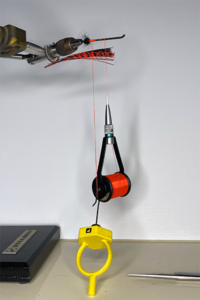 In this demo, we will be making a generic type intruder section. First, we make a dubbing ball at the rear of this Waddington shank. Then, make a normal dubbing loop approximately 6-8 inches in length. In the upper part of the dubbing loop, I insert my 1st material. I am using Lady Amherst tail fibers; but, you can choose any type of material.
In this demo, we will be making a generic type intruder section. First, we make a dubbing ball at the rear of this Waddington shank. Then, make a normal dubbing loop approximately 6-8 inches in length. In the upper part of the dubbing loop, I insert my 1st material. I am using Lady Amherst tail fibers; but, you can choose any type of material.
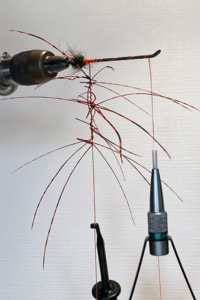 After I distribute the tail fibers to my satisfaction, I spin the dubbing loop normally. Now, this is very important for this process to work! Place some sort of clamp approximately mid way in your dubbing loop. Please note the clip attached to the mid section of the dubbing loop. This clip will prevent the top part of the dubbing loop from unraveling.
After I distribute the tail fibers to my satisfaction, I spin the dubbing loop normally. Now, this is very important for this process to work! Place some sort of clamp approximately mid way in your dubbing loop. Please note the clip attached to the mid section of the dubbing loop. This clip will prevent the top part of the dubbing loop from unraveling.
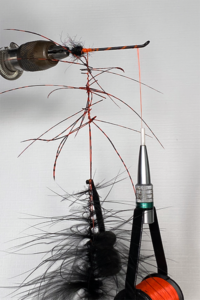 The bottom part of the dubbing loop is twisted and we need to get the twist out of the loop. There are various methods to achieve this. The simplest way is running a needle from the clip to the bottom of the loop until the dubbing loop opens back up. Now, place your 2nd material into this section of the loop. Next, spin the dubbing loop normally. Notice that the clamp prevents the top part of the dubbing loop from spinning.
The bottom part of the dubbing loop is twisted and we need to get the twist out of the loop. There are various methods to achieve this. The simplest way is running a needle from the clip to the bottom of the loop until the dubbing loop opens back up. Now, place your 2nd material into this section of the loop. Next, spin the dubbing loop normally. Notice that the clamp prevents the top part of the dubbing loop from spinning.
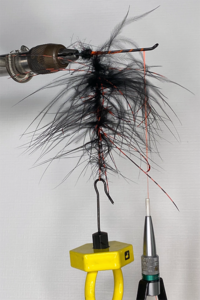 Now, place a 2nd dubbing spinner where the clamp is and remove the clamp. ( If you only have one dubbing spinner, place a hackle plier at the bottom of the entire dubbing and remove the dubbing spinner.) Fold the button section of the dubbing onto of the the top section and tie it off. The two sections are parallel to one another. Spin the two sections together and you have a composite loop.
Now, place a 2nd dubbing spinner where the clamp is and remove the clamp. ( If you only have one dubbing spinner, place a hackle plier at the bottom of the entire dubbing and remove the dubbing spinner.) Fold the button section of the dubbing onto of the the top section and tie it off. The two sections are parallel to one another. Spin the two sections together and you have a composite loop.
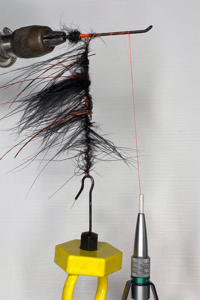 Once you are done building the composite dubbing loop, stroke the material rearward, making sure to comb out any trapped fibers. Make successive wraps in front of one another and tie off the dubbing loop.
Once you are done building the composite dubbing loop, stroke the material rearward, making sure to comb out any trapped fibers. Make successive wraps in front of one another and tie off the dubbing loop.
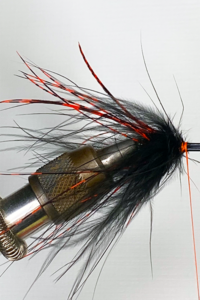 This method works for me. I have tried it with up to 4 different types of material (2 material types in each of the section). The reason I gravitated to this method was how little bulk is created and you are set up to build one smooth body. (See the base of the dubbing loop.)
This method works for me. I have tried it with up to 4 different types of material (2 material types in each of the section). The reason I gravitated to this method was how little bulk is created and you are set up to build one smooth body. (See the base of the dubbing loop.)
